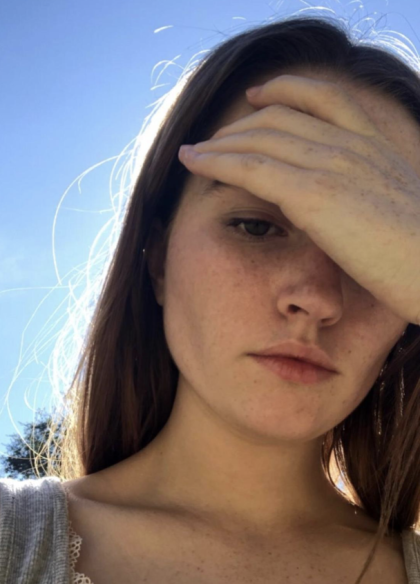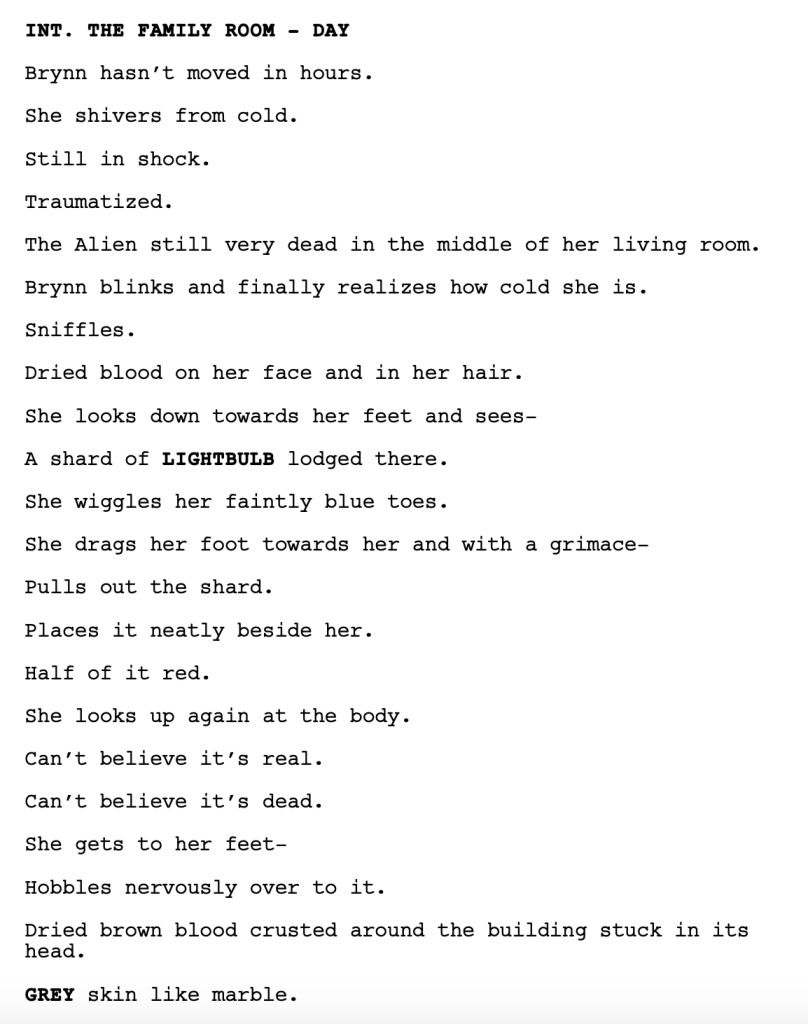Brian Duffield’s latest script asks the question, “Who needs dialogue?”
Genre: Horror/Sci-Fi
Premise: An exiled anxiety-ridden homebody must battle an alien who’s found its way into her home.
About: This is Brian Duffield’s latest script, which he will be directing. He’s got rising star Kaitlyn Dever (Booksmart, Unbelievable) starring in the title role. I don’t think I have to remind everyone of my love for Brian Duffield. He’s one of my favorite screenwriters!
Writer: Brian Duffield
Details: 90 pages
Will the writer with the most scripts ever to appear in my Top 25 add yet another script to the list? Let’s find out!
20-something Brynn lives all by herself in a house out in the woods. She spends her days buying those little holiday village buildings online and adding them to her growing little miniature town. She also likes to write letters to friends and dance by herself to music from the 30s on her record player. Yeah, Brynn doesn’t exactly live the FOMO life.
Brynn is also not well liked in town. Whenever she has to go into town to send her letters, we see people staring her down, giving her the evil eye. We’re not told why. But Brynn doesn’t have any friends around here. Which makes it sad when she visits her dead mother’s grave. Even there, people from other funeral processions stare.
One night, while Brynn is sleeping, she hears noise downstairs. When she goes to inspect the noise, she sees that it’s a gray alien. The alien spots her and begins chasing her around the house, climaxing in a face-off in the living room. Brynn takes one of the village buildings she collects and cracks it across the alien’s face, killing it instantly!
As soon as the alien dies, all the power, including the battery in her car, goes dead. It appears to have released some sort of EMPT bomb when it died. Brynn rides her bike to town the next morning to tell the police, but all of them stare at her coldly. Clearly, the police hate Brynn for some reason. By the way, there’s been no dialogue this entire movie so far.
Brynn decides that the only course of action is to leave town. But when she gets on the local bus, one of the passengers attacks her! Clearly, it is connected to the alien from her home somehow. The bus screeches to a stop and Brynn runs back to her town, having no choice but to go back home.
Once at the house, her worst fears come true. Aliens come back to pick up their own. These are much bigger, much scarier, aliens. And it takes every ounce of fight Brynn has left to elude them. But they eventually capture her. In our big final climactic moment, an alien places its finger on Brynn’s forehead, which sends us into a flashback of how Brynn ended up alone in this house, hated by the town. It acts as some sort of catharsis for Brynn, who, theoretically, can now move on with her life. But will she?
Let me show you what an average page of this screenplay looks like…
Brian Duffield may be the most minimalist screenwriter in Hollywood. Most of his action paragraphs in this script are one line. At most two. As a point of reference, I just got done with a screenplay consultation where I had to tell the writer he should probably scale back all the 8-line paragraphs.
Not enough writers think about the load of work they place on the reader. The more dense with text the pages are. The more characters there are in the story. The more plot there is. The more exposition that needs to be conveyed. All of these things factor into the workload you’re placing on the reader. The higher the workload, the better the script has to be because you’re making the reader work harder. And when the reader works harder, they want to be rewarded for that extra work.
That doesn’t mean every script should have two characters, a super-lean writing style, a thoughtless plot, and zero exposition. Writing a script like that has its own challenges, namely that ‘too simple’ can quickly become ‘too boring.’ All I’m saying is ‘workload’ is one of the factors you want to take into account before writing your script. Or choosing your concept. Because there is something to be said about making the reading experience easy.
Nobody understands that concept better than Duffield. I would even say that it was a key ingredient to his success. Nobody ever read a Brian Duffield script and said, “Man, that was such a long tedious read.” You may not have liked it, but it only took 60 minutes out of your life. Compare that to the post traumatic stress I’m still experiencing after the 4 hour battle I had with the “Mank” script.
As for the story itself, I have mixed feeling about No One Will Save You. I always wanted to keep reading. But I’m not sure I was satisfied with the payoff. In fact, I don’t know if I understood it. I’m going to reserve my thoughts about that to comments so that I don’t spoil anything here. If you understood the ending, head down to the comments so we can discuss.
My main issue with No One Will Save You is that 90% of it is running from one location to another. It may be from home to a bus stop. It may be from the kitchen to the living room. There’s only so much of “Brynn scurries behind the refrigerator” a reader can. It reminded me of one of my least favorite of Duffield’s scripts, The Babysitter, which also had the main character running around and hiding a lot.
Whenever I read an action script, which is essentially what this is, I’m looking for unique or stand-out set pieces. If you can come up with 4-5 inventive set pieces in a script like this, you can make a good movie. But if it’s all just running from one hiding spot to another, there’s no structure to that. Point A to Point B gets repetitive quickly.
No One Will Save You has one stand-out set piece, which occurs on the bus when Brynn is trying to escape town. The mailman (who was set up earlier as a creepy guy) ends up getting on the bus as well and we see him seated far back behind Brynn, who is unaware of his presence. As time goes on, we see him keep moving closer and closer to her, moving up from seat to seat. It’s super creepy and we’re screaming at Brynn to turn around. Of course, she doesn’t until it’s too late and he attacks her. That was a fun scene. But that was the only true set piece scene in the script. I wish there had been more.
I will say this was better than the similarly-themed “Trespasser” from a few weeks back. Much better. So there’s that.
Part of me reads a script like No One Can Save You and thinks, “This is a 45 minute movie.” Most scripts are around 20,000 words. This is maybe 12,000. Is that enough meat for a movie? I’m not convinced it is.
However, the other option is that Brian Duffield understands this generation better than the rest of us. He knows that nobody has time. He knows that everybody has options. So he writes in a way that’s quickly digested. And his movies move in a way that allow them to be consumed quickly. Should we be resisting this style or should we be following his lead?
[ ] What the hell did I just read?
[x] wasn’t for me
[ ] worth the read
[ ] impressive
[ ] genius
What I learned: There is no dialogue in this movie. There’s no doubt that this had a huge influence on why Duffield chose to convey the action via extreme minimalism. There’s no way to make a reader angrier than a script with little-to-no dialogue and BIG CHUNKY DESCRIPTION PARAGRAPHS. That’s every reader’s worst nightmare. Dialogue is the fastest part of the script to read. When you eliminate it, it takes three times as long to read the screenplay. Duffield identified that issue and curtailed the action lines so that the script still read fast. Smart move on his part.



